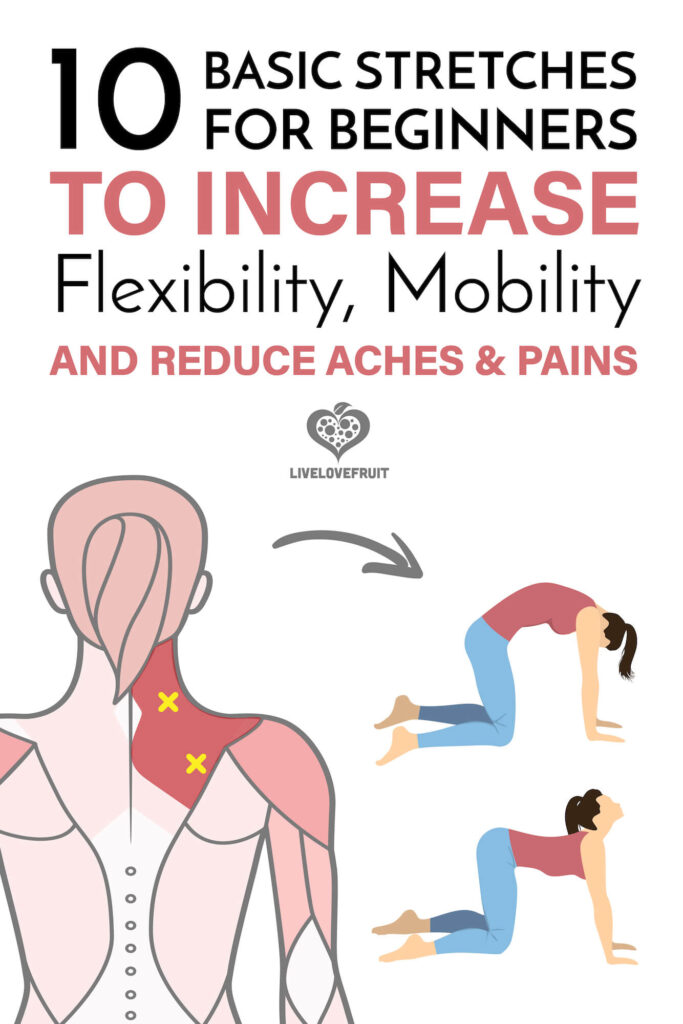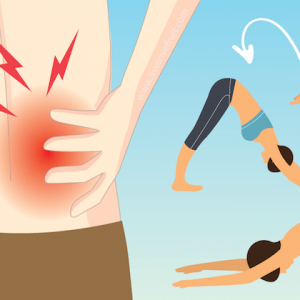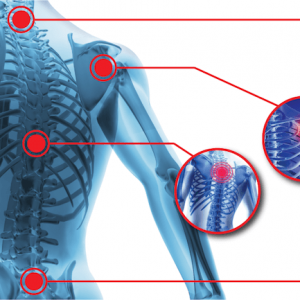
Stretching the body’s muscles provides freedom of movement, and also makes you feel good, too.
Stretching helps increase flexibility and improves your joint’s range of motion, allowing you to move more freely. Most of us suffer from some type of muscular tightness, with the most common being tight hamstrings, sore back, and stiff hips.
Types of Stretching
There are many different types of stretching, however, what we are most accustomed to is static stretching. Below are the many different forms you might come across (1).
• Static Stretch: holding a position for a period of time to the point of mild discomfort, usually 30 seconds or longer.
• Proprioceptive Neuromuscular Facilitation (PNF): involves holding a stretch while contracting and relaxing the muscles.
• Dynamic Stretch: gentle repetitive movement, such as arm swings, where you gradually increase the range of motion of the movement, but stay within the normal range of motion.
• Ballistic Stretches: going into a stretch and doing a bouncing or jerking movement to increase range of motion.
For this article, we are going to be focusing on static stretching.
What Are The Muscles Doing When We Stretch?
Our muscles are made up of hundreds of muscle fibres (2), within which lays hundreds of myofibrils. The myofibrils are composed of different proteins that hold them together, and they are organized into thick and thin filaments called myofilaments, which repeat along the length of the myofibril in sections called sarcomeres.

When a muscle is stretched, the area between the thick and thin filaments decreases, allowing the muscle fibre to elongate. Once the muscle has reached its maximum stretching length (all of the sarcomeres are fully stretched), additional stretching then extends to the surrounding connective tissue. The connective tissue basically takes up the remaining slack when the muscle fibre has reached its full length of stretching potential.
So, essentially, when you stretch to the point of mild discomfort (I am not talking about pain – you should never feel sharp pain when stretching, and if you do, don’t go so far into the stretch), the connective tissue helps to realign any disorganized muscle fibres in the direction of the tension, and therefore helps rehabilitate scarred tissue back to health.
Stretching regularly will help increase flexibility, by allowing the muscles to become more supple, and by retraining the nervous system to tolerate further stretching. Being consistent with stretching is important as well, considering it takes only four weeks for the body to lose flexibility once you stop stretching.
Therefore, you can see that if you haven’t stretched your body for years, getting back into it takes some time, and patience.
When To Stretch?
Most people think that stretching before exercise will help reduce your risk of injury, but this is actually not true. It actually makes your muscles weaker and slower when you stretch before exercise (3), and this can dramatically impact how well you exercise.
Stretching after you exercise will reduce injury and can even increase power and speed. If you don’t exercise, be sure to warm up for 10-15 minutes before hand by walking around the block or doing some dynamic stretches.
How To Stretch
Most people always tell me – “I can’t do that!” – when in fact, they haven’t even tried. Just because you see the image of someone going into a full forward bend, doesn’t mean that you need to get to that place just to feel a stretch. In fact, keeping your hands on your knees in a forward bend, or doing the best you can will slowly increase flexibility over time.
When stretching, keep them slow and gentle. Don’t bounce around, and breathe deeply. If you feel pain or sharp pain (not mild discomfort – this is normal), then you’ve stretched too far. Find a place in the stretch where you do not feel pain and breathe into the stretch.
Generally speaking, most stretches should be held for 10-30 seconds, or up to a minute if you can. You should feel a slight pull on each side, and you should stretch to the point of mild discomfort, otherwise, you’ll remain in the same place without ever gaining any flexibility. This stretching routine should be performed 2-3 days a week.
If you have serious health conditions, injuries, or are recovering from surgery, talk to your doctor of physical therapist about which stretches are right for you. This is a beginners stretching guide, and is simply here to provide you simple stretches that will allow you to graduate to more full-fledged stretching routines.
1. Lying Quad Stretch
Stretches the muscles in front of the thighs.
1. Lie on your left side, and bend your left elbow. Gently prop your head up with your left hand.
2. Bend your right knee and hold onto the top of your foot with your right hand (if you can’t reach your foot, wrap a towel around it and grasp the towel ends).
3. Gently pull your heel toward your bum. If you find balancing difficult, bend your bottom knee to provide support for your body.
4. Hold for 30 seconds, pressing your hips a bit forward to increase the stretch in the front of your thigh.
5. Release the stretch, roll over onto your right side, and stretch the left quad.
2. Shoulder Stretch
Stretches the the back of your shoulder muscles, and increases their flexibility.
1. Bring your left arm across your body and hold it with your right arm, either above or below the elbow.
2. Hold for about 30 seconds, then switch arms and repeat.
3. Seated Trunk Twist
Stretches the back, abdominals and obliques.
1. Sit tall on the floor, with your buttocks on the floor and legs extended together and in front of you.
2. Rotate your ribcage to the right, keeping your nose in line with the breastbone, and abs engaged.
3. Lift your ribcage off your hips to rotate further to the right, growing taller and twisting as far as you can.
4. Hold for 30 seconds, and then return to the centre, and repeat on the left side.
4. Seated Forward Bend In A Chair
Stretches the neck, back, and glutes.
1. Sit on a chair, keeping your knees together and your feet flat on the floor.
2. Inhale, and as you exhale, bend forward, rounding your shoulders and bending your back forward one vertebrae at a time.
3. Let your arms hang by your sides, and hold the pose for 3 deep breaths (if you have a bad back, let your arms rest on a table in front of you as you bend forward).
4. As you grow stronger and flexible, you can remove the chair and do this position as a standing forward bend.
5. Standing Triceps Stretch
Stretches the neck, shoulders, back, abs and triceps.
1. Stand with your feet hip-width apart, arms extended overhead.
2. Bend your right elbow so that your right palm lands on your upper back.
3. Reach the left hand over to grasp just below the right elbow and gently pull the elbow back and toward the head.
4. Hold for 30 seconds, switch arms, and repeat.
6. Basic Neck Stretch
Stretches the muscles of the neck, shoulder and upper back.
1. Bend your head forward and slightly to the right.
2. With your right hand, gently pull your head downward. You should feel a nice, easy stretch along the back left side of your neck.
3. Hold for 30 seconds, and then repeat on the other side.
7. Hamstring Stretch
Provides a great stretch through the whole length of the hamstrings.
1. Stand tall with your back straight, core engaged, shoulders down and feet hip-width apart.
2. Bring your left leg forward, heel down, toes up and leg straight.
3. Keeping your back straight, bend the right knee as if you were sitting back, while supporting yourself with both hands on your thighs.
4. Hold for 30 seconds, and then repeat on the opposite side.
8. Cat And Cow
This pose develops flexibility in the entire spine. It stretches and lengthens the back torso and the neck, and can open and create space throughout the entire neck.
1. Start with your hands and knees on the floor, palms directly under the shoulder rand knees directly below the hips.
2. Breathe in and pull your abdominal muscles in as you arch your back up like a stretching cat. Let your head and tailbone drop down toward the floor.
3. Return to the initial position, and then extend the upper part of the spine upwards, supporting it with your abdominal muscles and not letting your neck sink into your shoulders, or your shoulders crunch up into your neck. Make sure your neck is a long extension of your spine, and don’t let the head fall back.
4. Return to starting position and repeat 5 times.
9. Figure Four Stretch
A great stretch for the glutes and outer hip tightness.
1. Laying on the ground on your back, cross the left leg over the right with the ankle resting on the right knee.
2. Reach and connect your hands behind the hamstring of the right leg.
3. Gently pull the hamstring towards your belly and feel a stretch on outer side of the left leg.
4. Breathe deep, hold for 60 seconds, and release. Repeat on the opposite side.
10. Calf Stretch
A great stretch for every muscle in the calves.
1. Stand at arm’s length from a wall and place your right foot behind your left foot.
2. Slowly bend your left leg forward, keeping your right knee straight and your right heel on the floor.
3. Hold your back straight and your hips forward, while not rotating your feet inward or outward.
4. Hold for 30 seconds, and then switch legs and repeat.
5. To make this stretch even deeper, bend your right knee as you bend your left leg forward.









Thank you for the information. This helps a lot, maybe I'll spend more time getting motivated.
Yes! You gotta start somewhere 🙂 Good luck!
Is there a way I can print out these exercises so I can share them with my sister. She does not have a computer. Thank you
You could always copy and paste into a word document 🙂 Or under file you can select "print" and it will print off the page for you!